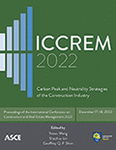Research on the Construction Safety Accident Analysis Model of Deep Excavation Project Caused by Rainstorm
Publication: ICCREM 2022
ABSTRACT
The deep excavation construction project becomes more vulnerable to storm disasters along with the tendency of its large scale, longer construction period, and complex process. This paper is aimed at revealing the mechanism of the construction safety accident caused by rainstorm. Firstly, the key factors of the safe construction of excavation project are systematically analyzed. Secondly, the system dynamics model is established based on six subsystems, which are workers, project entity, rescue equipment, adjacent environment, safety protection facilities, and rainstorm intensity. Thirdly, the key safety variables, accident causal chain, and safety risk coupling relationship was identified and analyzed while the model is solved by intelligent algorithm. Lastly, the typical projects are selected for empirical analysis, and the calculation results show that the model can well simulate and analyze the evolution mechanism of the construction accidents and can provide reference for the safety prevention measures of deep excavation in rainstorm weather.
Get full access to this article
View all available purchase options and get full access to this chapter.
REFERENCES
Chen, W., Qiao, Z., Wang, W. Z., Zhang, K. L., Niu, L., and Deng, C. (2017). “SD model for emergency disposal of construction safety accident caused by rainstorm disaster.” China Safety Science Journal, 27(06), 169–174. (in Chinese).
Cheng, H. Q., She, J. X., Yuan, N., and Peng, Z. H. (2016). “Synthetic evaluation on risk of deep excavation engineering construction process.” Journal of Tongji University (Natural Science), 44(03), 491–498. (in Chinese).
Dong, L. D. (2021). “Application of GPS-RTK in excavation project monitoring.” Construction and Architecture, (17), 75–76. (in Chinese).
Farzi, M., Pakbaz, M. S., and Aminpour, H. A. (2018). “Selection of support system for urban deep excavations: A case study in Ahvaz geology.” Case Studies in Construction Materials, 8, 131–138.
Gong, X. N. (2005). “Considerations on foundation pit engineering.” China Civil Engineering Journal, (09), 99–102+108. (in Chinese).
Hou, S. N., Yue, J. Y., and Zhou, Y. (2021). “Design and practice of partitioning of deep large foundation pits under complex environment conditions.” Journal of Architecture and Civil Engineering, 38(06), 119–127. (in Chinese).
Huang, B. W. (2013). “Analysis of construction safety measures under disastrous weather in Xi’an area.” Construction Safety, 28(09), 65–67. (in Chinese).
Jiang, W. Z., and Tan, Y. (2021). “Heavy rainfall-related excavation failures in China during 1994 to 2018: An overview.” Engineering Failure Analysis, 129, 105695.
Li, Z. P., and Zhang, M. (2000). “Study on effects of rainfall infiltration on safety of excavation slope.” China Safety Science Journal, (03), 16–22. (in Chinese).
Liang, Q., Zhou, Z. Y., Ye, G., and Shen, L. Y. (2022). “Unveiling the mechanism of construction workers’ unsafe behaviors from an occupational stress perspective: A qualitative and quantitative examination of a stress-cognition-safety model.” Safety Science, 145, 105486.
Liu, B., Xu, W., Zhang, D. W., and Zhang, Q. B. (2022). “Deformation behaviors and control indexes of metro-station deep excavations based on case histories.” Tunnelling and Underground Space Technology Incorporating Trenchless Technology, 122, 104400.
Wu, J. J., Peng, L. M., Li, J. W., Zhou, X. Y., Zhong, J. B., Wang, C., and Sun, J. (2021). “Rapid safety monitoring and analysis of foundation pit construction using unmanned aerial vehicle images.” Automation in Construction, 128, 103706.
Zeng, C. F., Zheng, G., Zhou, X. F., Xue, X. L., and Zhou, H. Z. (2019). “Behaviours of wall and soil during pre-excavation dewatering under different foundation pit widths.” Computers and Geotechnics, 115, 103169.
Zheng, G., Zhu, H. H., Liu, X. R., and Yang, G. H. (2016). “Control of safety of deep excavations and underground engineering and its impact on surrounding environment.” China Civil Engineering Journal, 49(06), 1–24. (in Chinese).
Zhou, H. B., and Cai, L. B. (2015). “Risk and control of the artesian water for deep excavation engineering in soft soil area.” Journal of Tongji University (Natural Science), 43(01), 27–32. (in Chinese).
Information & Authors
Information
Published In
History
Published online: Dec 15, 2022
Authors
Metrics & Citations
Metrics
Citations
Download citation
If you have the appropriate software installed, you can download article citation data to the citation manager of your choice. Simply select your manager software from the list below and click Download.
